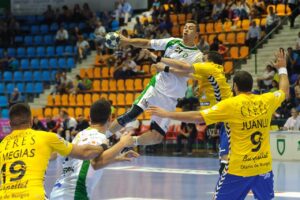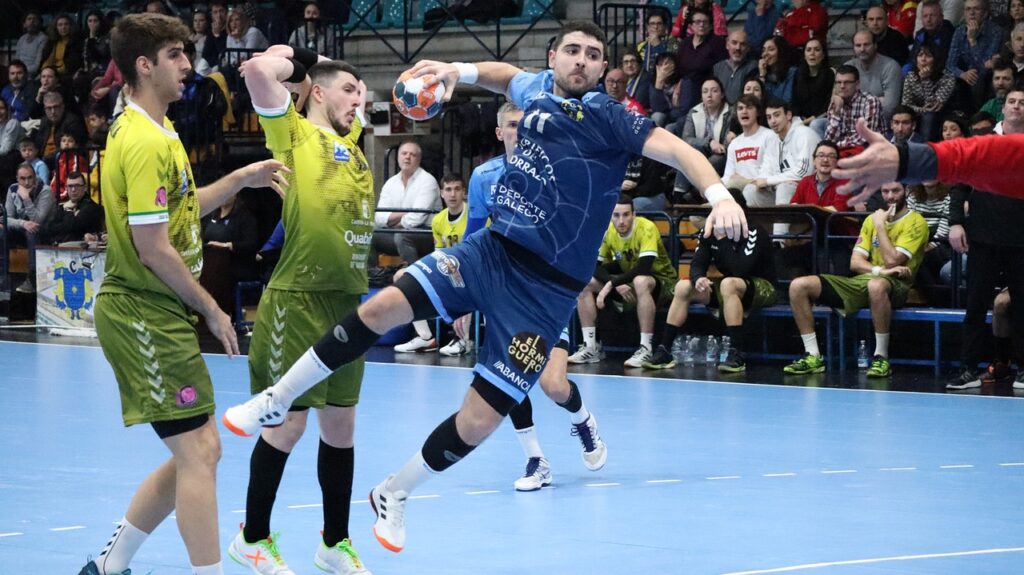HANDBALL PHYSICAL PREPARATION: THE COMPLETE GUIDE WITH KETTLEBELL
The kettlebell for handball physical preparation?
Handball is a dynamic and demanding team sport requiring a wide range of physical qualities such as strength, speed, agility and endurance. To reach their full potential in competition, handball players must train rigorously and systematically, following physical preparation programs adapted to their sport.
Physical preparation is therefore essential for handball players, enabling them to develop the physical qualities they need to perform at their best throughout the season. However, physical preparation should not be seen as a tedious, repetitive task, but rather as an opportunity for players to perfect their skills and improve their performance.
With this in mind, the kettlebell is an increasingly popular physical preparation tool for handball players, due to its many benefits for strength, endurance and coordination. Kettlebell training can be used in a variety of ways to meet the specific needs of handball, particularly for the development of explosive strength and muscular power.
In the remainder of this article, we’ll explore in detail the various components of physical preparation for handball, as well as the specific benefits of the kettlebell for handball players.
Handball physical preparation
Components of physical preparation for handball
The aim of physical preparation in handball is to develop the physical qualities of players in order to maximize their performance in matches. The main objectives of physical preparation in handball are :
- Improve players’ overall physical condition
- Increase muscular strength and power
- Develop speed and agility
- Increasing endurance
To achieve these objectives, physical preparation in handball must take into account the different physical components involved in the sport. The main components are :
Muscular strength and power
Muscular strength and power are essential physical qualities for handball players, enabling them to perform fast, explosive movements such as shooting and passing.
Speed and agility
Speed and agility are also crucial physical qualities in handball, enabling players to move quickly around the court, change direction instantly and gain an advantage over their opponents.
Endurance
Endurance is also an important component of physical preparation in handball, as the sport involves repetitive physical effort over an extended period. Players must be able to maintain a high level of effort throughout the match.
Examples of exercises and training methods used in physical preparation for handball
To improve these different physical components, handball players use a variety of exercises and training methods adapted to their specific needs. Here are a few examples of exercises and training methods commonly used in physical preparation for handball:
- Circuit training: a high-intensity workout that combines strength and endurance exercises in a single circuit.
- Plyometric training: training focused on explosive power and speed, including jumps, leaps and fast-moving exercises.
- Strength training: a workout focused on muscular strength and power, using free weights, machines or resistance bands.
- Sprint training: speed and agility training, including short sprints and rapid changes of direction.
- Cardiovascular training: a workout focused on improving overall fitness, which may include running, swimming, cycling or jumping rope.
Physical preparation is therefore essential for handball players, enabling them to develop the skills they need to succeed on the court. With the right combination of strength, power, speed, agility and endurance, handball players can perform better and reduce their risk of injury.
Now that we’ve seen the various components of physical preparation in handball, let’s focus on a particularly useful tool for improving general fitness, strength and muscular power: the kettlebell.

Handball physical preparation with kettlebell
Advantages of using the kettlebell in handball physical preparation
The kettlebell is a ball-shaped body-building tool with a handle on top. It is used for strength, power, endurance and coordination exercises. The kettlebell is becoming increasingly popular in the world of bodybuilding and physical preparation due to its many advantages.
Complete muscle strengthening :
The kettlebell works the whole body, in particular the back, shoulders, legs and abdominal muscles. Kettlebell exercises are often functional movements that call on several muscle groups at once, developing strength and power in a balanced way.
Improved overall fitness :
The kettlebell is a highly effective tool for improving overall fitness. Kettlebell movements can be very intensive and require a great deal of effort, helping to improve the cardiovascular and respiratory capacity of handball players.
Work on balance and coordination :
Kettlebell exercises also train balance and coordination, two important skills for handball players. Kettlebell movements require good stability and body control, which can help players improve their agility and ability to change direction quickly.
Circuit training available :
The kettlebell is a very versatile tool and can be used in circuit training sessions. Kettlebell exercises can be combined with cardio, strength and agility exercises to create complete and effective workouts.
The kettlebell is therefore a very useful tool for handball players wishing to improve their general fitness, strength, power, balance and coordination. Kettlebell exercises can be integrated into handball-specific physical preparation programs to help players reach their peak performance levels on the field.
Examples of kettlebell exercises for handball
Kettlebell swing :
The swing is a basic kettlebell exercise that can help improve muscle power and coordination. To perform this exercise, hold the kettlebell with both hands and stand with feet shoulder-width apart. Then bend your hips and knees to lower the kettlebell between your legs, and use the strength of your legs and hips to propel it up to shoulder height. Repeat for several repetitions.
Kettlebell goblet squat:
The goblet squat with kettlebell is a great way to strengthen leg and core muscles, which are important for fast movements and changes of direction on the pitch. To perform this exercise, hold the kettlebell in front of your chest with both hands and slowly lower yourself into a squat position, keeping your back straight. Return to a standing position and repeat for several repetitions.
Kettlebell turkish get-up :
This exercise is excellent for developing strength, balance and stability in the shoulders, hips and legs, which is important for throwing and blocking movements in handball. To perform this exercise, lie on your back with a kettlebell held in one hand and the other arm stretched out on the floor. Slowly rise to a standing position while holding the kettlebell above your head. Then slowly return to the lying position and repeat with the other arm.
Kettlebell clean :
The kettlebell clean is an excellent exercise for improving muscular strength and coordination, as well as strengthening back and leg muscles, which are important for throwing and blocking movements in handball. To perform this exercise, grab the kettlebell with one hand and stand with your feet shoulder-width apart. Then use the strength of your legs and hips to lift the kettlebell up to your shoulder in the rack position. Repeat for several repetitions and change hands.
This list of exercises is not exhaustive, but it gives an idea of the variety of exercises that can be performed with the kettlebell to improve physical preparation for handball. It’s important to note that kettlebell use requires proper technique and supervision to avoid injury and achieve the best results.

Handball physical preparation program with kettlebell
Here’s an example of a kettlebell fitness program for handball. The program is structured around two typical weeks, with two sessions per week. You can repeat this cycle 3 to 4 times, for a total training time of 6 to 8 weeks.
Week 1 – Session 1 :
Warm-up: 5 minutes of skipping rope
Kettlebell swings: 4 sets of 10 repetitions, 30-second rest between each set
Goblet squats with kettlebell: 4 sets of 8 repetitions, 30-second rest between each set
Turkish get-up: 4 sets of 6 repetitions (3 on each side), 30-second rest between each set
Plank: 3 series of 30 seconds, 30 seconds rest between each series
Week 1 – Session 2 :
Warm-up: 5 minutes of skipping rope
Kettlebell cleans: 4 sets of 6 repetitions (3 on each side), 30-second rest between each set
Lunges with kettlebell: 4 sets of 10 repetitions (5 on each side), 30-second rest between each set
Kettlebell push press: 4 sets of 8 repetitions, 30 seconds rest between each set
Lateral gainage: 3 sets of 30 seconds on each side, 30 seconds rest between each set
Week 2 – Session 1 :
Warm-up: 5 minutes of skipping rope
Kettlebell swings: 4 sets of 12 repetitions, 30-second rest between each set
Squats with kettlebell: 4 sets of 10 repetitions, 30-second rest between each set
Push-ups with hands on kettlebell: 4 sets of 8 repetitions (4 on each side), 30-second rest between each set
Plank: 3 sets of 45 seconds, 30 seconds rest between each set
Week 2 – Session 2 :
Warm-up: 5 minutes of skipping rope
Kettlebell snatch: 4 sets of 8 repetitions (4 on each side), 30-second rest between each set
Lunges with kettlebell: 4 sets of 12 repetitions (6 on each side), 30-second rest between each set
Kettlebell floor press: 4 sets of 10 repetitions, 30-second rest between each set
Lateral gainage: 3 sets of 45 seconds on each side, 30 seconds rest between each set
It’s important to note that this program is an example, and can be adapted to suit individual needs and specific objectives. It’s also important to get enough rest between sessions, and to ensure a balanced diet and good hydration to aid recovery and progress.
Other articles that might interest you:
- GPP for running with kettlebell
- MMA physical preparation with kettlebell
- Military training with kettlebell
- Abs exercises with kettlebell
- WOD with kettlebell in CrossFit
- Bodybuilding with kettlebell
- Kettlebell exercises for women
- Kettlebell HIIT
- Kettlebell sport : all you need to know
- Tennis physical preparation with kettlebell
- Basketball physical preparation with kettlebell
- Rugby physical preparation with kettlebell
- Skiing physical preparation with kettlebell
- Football physical preparation with kettlebell

